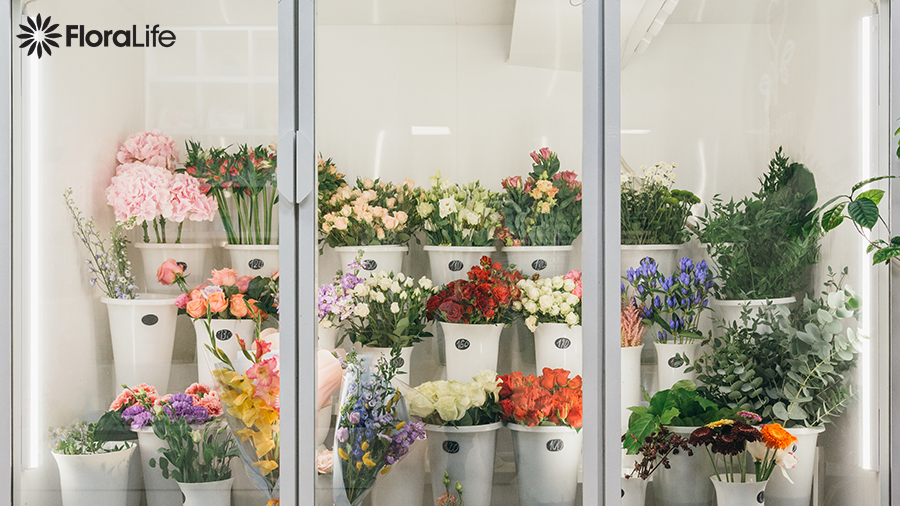Best Floral Care Requires Keeping Cool
powered by FloraLife

It’s happened to all of us. It’s the dead heat of summer and the air conditioner dies. We don’t mean like oops there was a power surge and it kicks back on, no this is a full-on air-conditioning meltdown. You are hot… your brow begins to glisten and then gives way to a full-on sweat. You’ve stripped down to the bare minimum clothing, and you are drinking water like a fish to try to stay hydrated. You are taking every measure possible to stay cool. Flowers are exactly the same!
When conditions are extreme, especially heat, flowers will like people begin to increase respiration at a much faster rate. The need for water intake and continued water intake in order to maintain temperature and not “dry out” will be increased immensely. Always the best course of action with cut flowers is to maintain constant temperature and avoid extreme heat, cold or drafts. Should you experience a spike in temperature be sure to check water/solution levels in vases and buckets as well as condensation that may have developed on the inside of sleeves. Sleeves with condensation should be removed or changed immediately to avoid botrytis or other complications.
Importance of temperature and cold chain remain key to floral care and handling
Among the best practices for cut flowers, adherence to correct temperatures and attention to cold chain management are two of the easiest protocols for the floral industry to follow, with results that prove it’s well worth the time and effort.
In today’s floral industry, the journey flowers take can be a lengthy one, which often means transporting flowers great distances so products are within a retailer’s reach. Because a majority of cut flowers are imported from other countries, it’s important to adhere to proper care and handling procedures to ensure each stem arrives in peak condition.
Thankfully, advancements in temperature technology and cold chain management help the majority of imported flowers arrive healthy and vibrant, with plenty of vase life remaining.
Extending the Life
The cold chain is arguably the most important link in the management of flowers that needs to start almost immediately postharvest. It should remain consistent through all aspects of the flowers’ journey, starting at farm level and going from field to floral professionals, with coverage in transport and customs, and continuing at its shop destination.
The key factor throughout the cold chain process is effectively maintaining a cool temperature somewhere between 34°F / 1°C and 37°F / 3°C.
Once flowers are picked, the COLD CHAIN STARTS from the fields. The postharvest process includes hydrating and treating flowers in a refrigerated room in order to remove field heat before being graded, bunched and sleeved. Flowers should continue staying cooled as they leave the farm.
Today, just about all trucks transporting flowers include refrigeration, allowing flowers to remain cool until the moment they need to be loaded into a plane. But even that process is now also temperature-controlled so once the air freight lands, it’s immediately placed in a refrigerated hall at the airport, where it’s inspected by customs officials. Then, it’s back into a refrigerated truck and sent onto its final destination.
Consistency is Key
Although many different people contribute to the journey flowers take, it’s imperative to ensure that the temperature of the flowers doesn’t vary too much throughout its travel process. Adhering to temperature guidelines is essential and avoiding too much fluctuation is key to having shipments arrive intact with plenty of vase life.
This is because flowers can easily become stressed when temperatures rise and lower repeatedly, which could cause them to produce ethylene and develop condensation inside the flower packaging.
Relative humidity also plays a role as water in the air can hurt a flower’s shelf life. Flowers in transit will lose water, causing what’s known as “water stress,” which can lead to bent necks and premature wilting. Because of this, relative humidity should be approximately 75 – 85% – with anything higher, condensation will occur, which could cause botrytis to develop.
Don’t Ignore the Cold Chain
Upon arrival, flowers should be immediately placed in cold storage – at a temperature equal to what they traveled in – and taken out when ready to sell. For grocery floral businesses, staff should think about flowers separately from produce. Although both need to go through a similar process of cooling, flowers need to be stored in a clean if possible non-produce cooler as they can be easily damaged by the ethylene gas produced from ripening produce.
Anyone in the floral industry who doesn’t pay attention to temperature or proper cold chain management risks learning the hard way that this can be detrimental to a business. Some people think once flowers arrive, temperature control is no longer as important as when the flowers were in transit – but that’s very far from accurate. The care and handling that flowers get – whether from farm to wholesaler, florist or mass market – remains the most important steps in providing the best quality flowers that keep customers happy and returning.
Best Practices
No matter what time of year it is you are always on the journey to fresh! Maintaining your best practices checklist always guarantees the longest possible vase life:
- Sanitation – The importance of cleanliness is often underestimated. Research has shown that dirty buckets can reduce the vase life of a rose by up to 20%. Make sure that everything – buckets, cutters, coolers, benches, and so on – is cleaned with an approved disinfectant cleaner which has a residual effect, such as FloraLife® D.C.D.® Cleaner.
- Hydrate – For best results when processing dry pack or re-processing flowers, cut and dip in an instant hydrating treatment such as Floralife® Quick Dip to jump-start hydration and ensure free-flowing stems. This is a must for roses and Gerberas to help prevent bent necks.
- Nourish – After such a long journey flowers really need to be nourished and fed. Using a flower food solution such as Floralife® Express will provide flowers with what they need to thrive.
- Protect – Use a professional finishing spray such as Floralife® Finishing Touch to refresh, hydrate and protect your flowers. Quick and easy to apply, this is a final step before your arrangements go out the door. A simple fine-mist spray is all it takes to maximize customer satisfaction and extend the enjoyment of receiving flowers.
- Customer care – You’ve done everything right, now it’s up to your customer to take these flowers home and make them last. Buying flowers can be intimidating to some. As the flower expert, offer lots of advice on the steps to follow at home. Educate your customers or the recipients of your flowers on how to care for the flowers. Caution them about placing flowers in direct sunlight, drafty places, or near heating and cooling vents. Remind them to change the flower-food solution every 3 days. And provide flower food packets like FloraLife® Express with every purchase and delivery – enough to enable consumers to change the solution throughout the life of the arrangement or bouquet. This is your best insurance policy to guarantee that the freshness will continue.
To learn more about best practices from the experts in flower care, visit www.floralife.com
*Product availability depends upon geographical region
